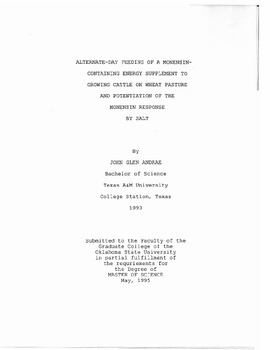| dc.description.abstract | Wheat pasture is regarded as a source of high quality forage capable of producing rapid rates of gain for ruminant livestock. However, the chemical characteristics of this forage may also limit animal performance. Wheat forage commonly has DOM and CP levels which approach 75% and 30% of total forage DM, respectively, with much of the N present as NPN (Horn, 1984). Stewart et ale (1981) reported that K concentrations of wheat forage in El Reno, OK often were greater than N concentration and regularly exceeded 4% of DM. Mayland et al. (1976) reported K concentrations of hard red spring wheat forage ranging from 3.1 to 3.3% between mid-April and mid-May. Sodium concentrations of forage are, however, typically low and may vary from 0.12 to 0.55% of DM (Morris, 1980). The high CP levels of wheat pasture can result in low forage DOM:CP ratios. Hogan (1982) reported that a DOM:CP ratio of less than 4:1 is condusive to the loss of large amounts of N from inefficient microbial protein synthesis. Energy supplementation increases the DOM:CP ratio and supplies energy for microbial synthesis. In the past, energy supplementation of growing cattle on wheat pasture has served primarily to allow increases in stocking density by substituting silage or grain for wheat forage (Horn et al., 1995). Increases in daily gain of cattle grazing wheat pasture without changes in stocking density from energy supplementation of cattle grazing wheat pasture have also been previously observed (Horn et al., 1988, 1990; Beck et al., 1993; Andrae et al., 1994). Inclusion of monensin in energy supplements increases daily weight gains of beef cattle consuming forage diets approximately .09�kg�hd-1�ct-1 (Potter et al., 1986), and has decreased the incidence and severity of frothy bloat (Branine and Galyean, 1990; Grigsby, 1984). However, decreased ionosphere effectiveness has been observed in vitro in the presence of high K levels (Dawson and Boling, 1987). Increased ionophore effects have been reported at high K levels when Na levels were increased both in vitro (Dawson et al., 1983; Schwingel et al., 1989) as well as in vivo (Rumpler et al., 1986; Spears and Harvey, 1987). Increasing dietary Na levels with ionosphere supplementation has also resulted in no beneficial VFA or gain responses in vivo (Karr et al., 1990; Muller et al., 1986). Because of the high K:Na ratios of wheat forage, increasing salt levels of supplements may increase rumen and weight gain responses to monensin. Consistent supplement conversions (5 kg supplement/kg added gain) and increases in live weight gains (.23 kg�hd-1�d-1) have been reported when a small package self-limiting-monensin-containing supplement consisting of approximately_4% salt was fed to steers grazing wheat pasture (Horn et a1., 1990, 1992; Beck et al., 1993). Thus, the objective of this study was to examine the ruminal effects of a monensin-containing energy supplement which contained either 0% or 5% salt when fed to steers grazing wheat pasture. In previous studies aimed at developing a self-limiting monensin-containing energy supplement for growing cattle on wheat pasture, daily gains were consistently increased by about .23 kg�hd-1�d-1 and profits were increased by $15 to $31 per head, depending on feed cost and cattle profit potential (Beck et al., 1993; Horn et al., 1990, 1992). While some producers prefer self-fed supplements, others prefer hand feeding. Thus, another objective was to determine the effects of hand-feeding a monensin-containing energy supplement on an every other day basis to stocker cattle grazing wheat pasture. | |
